How to Master the Clarinet
A Comprehensive Guide for Beginners and Beyond
Listen to the Audio “How to Master the Clarinet”

Are you ready to embark on a musical journey with the clarinet? Whether you’re a complete beginner or a seasoned player looking to take your skills to the next level, “How to Master the Clarinet: A Comprehensive Guide for Beginners and Beyond” has got you covered.
This guide is designed to be your ultimate companion in mastering this beautiful and versatile instrument. From learning the basics of holding and assembling the clarinet to exploring advanced techniques and musical styles, we provide you with step-by-step instructions, expert tips, and practice exercises that will enhance your playing and musicality.
Our comprehensive approach ensures that you not only develop a solid foundation but also have the tools to continue growing as a clarinettist. With our easy-to-follow instructions and engaging content, you’ll be able to unlock your full potential and experience the joy of playing the clarinet like never before. So, grab your instrument, dive into the world of clarinet music, and let’s begin this exciting musical journey together!
Choosing the Right Clarinet
When starting your clarinet journey, it’s essential to choose the right instrument that suits your needs and preferences. The clarinet comes in various sizes and materials, such as E-flat/E-flat sopranino the most common clarinet, B-flat clarinet, A clarinet and the less common bass clarinets. Each type has its unique sound and range, catering to different musical styles and ensembles.
Consider factors like your skill level, budget, and the type of music you want to play before deciding. Research different brands, try out different models, and seek guidance from knowledgeable musicians or music teachers to find the perfect clarinet that resonates with you.
Understanding the Parts of the Clarinet

Before diving into playing the clarinet, it’s crucial to familiarize yourself with its different parts. The clarinet consists of the mouthpiece, barrel, upper joint, lower joint, and bell. Each part plays a significant role in producing sound and requires proper handling and care.
Take the time to learn the names and functions of each component, as this knowledge will be useful when assembling and maintaining your instrument.
Understanding the parts of the clarinet will also help you communicate effectively with other musicians and troubleshoot any issues that may arise during your practice sessions or performances.
Proper Assembly and Maintenance of the Clarinet
Now that you’re familiar with the parts of the clarinet, let’s explore the proper assembly and maintenance techniques. Assembling the clarinet correctly ensures optimal playability and longevity of your instrument.
Start by carefully connecting the upper and lower joints, ensuring a secure fit without forcing the pieces together. Next, attach the barrel to the upper joint, followed by the bell to the lower joint. Always handle the clarinet with care, avoiding excessive pressure or gripping that could damage the keys or delicate mechanisms.
Regular maintenance, such as cleaning the instrument after each use and oiling the keys, is essential for keeping your clarinet in good condition. Consult your clarinet’s manual or seek guidance from a professional if you’re unsure about any specific maintenance procedures.
Basic Clarinet Playing Techniques
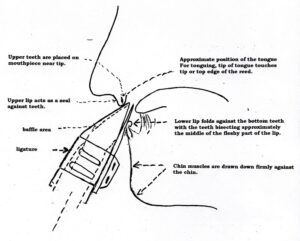
Now that your clarinet is assembled and maintained, it’s time to explore the basic playing techniques. Start by practicing proper hand positioning, ensuring a relaxed grip and correct finger placement on the keys.
Position your embouchure, the way you shape your lips and mouth around the mouthpiece, to produce a clear and resonant sound. Begin with long tones, focusing on producing a steady and even sound throughout the full range of the clarinet.
Gradually introduce articulation techniques, such as tonguing and slurring, to add variety and expression to your playing. Remember to start slow and practice with a metronome to develop a sense of rhythm and accuracy.
Regular practice, even for short durations, will help you build strength, flexibility, and control over your playing.
Essential Clarinet Scales and Exercises
To develop fluidity and agility on the clarinet, it’s crucial to practice scales and exercises regularly. Start with major scales, gradually increasing the number of flats or sharps as you become more comfortable.
Practice these scales in different octaves, focusing on evenness of tone and accuracy of fingering. Incorporate scale patterns and exercises that target specific technical challenges, such as finger dexterity, articulation, and interval jumps. Scales and exercises not only improve your technical proficiency but also enhance your ability to navigate the clarinet’s range and play with confidence in different musical contexts.
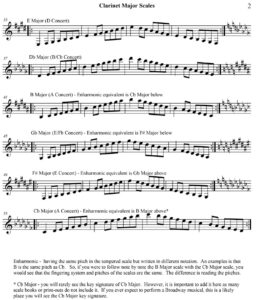
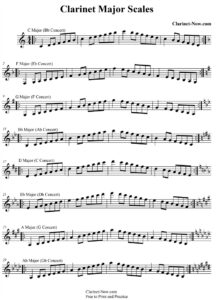
Mastering Clarinet Fingerings
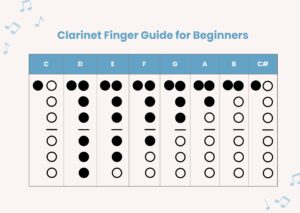
Understanding and mastering clarinet fingerings is essential for playing accurately and effortlessly. Spend time memorizing the fingerings for each note on the clarinet, starting from the lowest register and gradually working your way up.
Practice ascending and descending scales, arpeggios, and melodic passages to reinforce your knowledge of fingerings and develop muscle memory. As you progress, experiment with alternate fingerings and trill fingerings to expand your tonal palette and execute challenging passages with ease.
Regular finger technique exercises will strengthen your fingers and improve your overall control and agility on the instrument.
Developing Proper Embouchure and Breath Control
The clarinet’s unique sound is greatly influenced by the player’s embouchure and breath control. The embouchure refers to the way you shape your lips and position your mouth on the mouthpiece. Experiment with different embouchure positions to find the one that allows you to produce a clear and resonant sound with minimal effort.
Proper breath control is equally important, as it determines the quality of your tone and your ability to sustain long notes. Practice long tones, focusing on maintaining a steady stream of air and achieving a consistent tone throughout different registers of the clarinet.
Regular exercises that strengthen your diaphragm and improve breath support will greatly enhance your overall playing and musicality.
Reading Sheet Music for the Clarinet
Reading sheet music is an essential skill for any clarinettist. Familiarize yourself with the musical staff, clefs, note names, rhythms, and dynamics. Start by practicing simple melodies and gradually progress to more complex pieces. Break down the music into smaller sections and practice them at a slower tempo before gradually increasing the speed.
Pay attention to articulation markings, dynamics, and phrasing to bring the music to life. As you become more proficient in reading sheet music, challenge yourself with different musical genres and styles to expand your repertoire and develop a versatile playing ability.
Tips for Improving Tone and Dynamics
Achieving a beautiful tone and expressive dynamics on the clarinet requires attention to detail and consistent practice. Experiment with different mouthpiece and reed combinations to find the setup that best suits your playing style and desired sound. Focus on producing a warm and resonant tone by using proper breath support, embouchure control, and tongue position.
Explore different dynamic ranges, from pianissimo to fortissimo, to add nuance and emotion to your playing. Practice long tones, dynamic exercises, and expressive etudes to refine your tone production and dynamic control. Regularly record yourself to evaluate your progress and make necessary adjustments to achieve your desired sound.
Advanced Clarinet Techniques and Extended Techniques
Once you have a solid foundation in the basics, it’s time to explore advanced clarinet techniques and extended techniques. These techniques allow you to create unique sounds and expand your musical possibilities.
Techniques such as multiphonics, circular breathing, flutter-tonguing, and glissando add colour and texture to your playing. Experiment with different articulation styles, such as staccato, legato, and accents, to create variety and expressiveness in your performances. Incorporate extended techniques gradually into your practice sessions, ensuring that you maintain control and precision while exploring new sonic possibilities.
Exploring Different Music Genres on the Clarinet
The clarinet is a versatile instrument that can be found in various music genres, from classical and jazz to folk and pop. Once you have a solid foundation in playing the clarinet, explore different music genres to broaden your musical horizons.
Listen to recordings of renowned clarinettists in different genres to understand their playing styles and techniques. Experiment with different musical styles by playing along with recordings or joining ensembles that specialize in specific genres. Embrace the diversity of the clarinet and discover the joy of expressing yourself through different musical languages.
Finding the Right Clarinet Teacher or Mentor
Having a knowledgeable and experienced clarinet teacher or mentor can greatly accelerate your learning and provide valuable guidance. Seek recommendations from other musicians, music teachers, or local music schools to find a teacher who suits your learning style and goals.
A good teacher will not only help you improve your technique and musicianship but also provide valuable insights and inspire you to reach your full potential. Regular lessons and feedback from a teacher or mentor will keep you motivated, accountable, and on track in your clarinet journey.
Resources for Further Clarinet Learning and Inspiration
In addition to having a teacher or mentor, there are numerous resources available to further your clarinet learning and provide inspiration. Explore clarinet method books, etudes, and repertoire that cater to your skill level and musical interests.
Online platforms, such as video tutorials and online courses, offer a wealth of information and instructional materials for self-guided learning. Attend clarinet workshops, masterclasses, and concerts to connect with other clarinettists and gain exposure to different playing styles and techniques.
Immerse yourself in the world of clarinet music by listening to recordings of legendary clarinettists and attending live performances whenever possible. The more you engage with the clarinet community and immerse yourself in the music, the more inspired and motivated you’ll become in your clarinet journey.
Conclusion: Enjoying the Journey of Mastering the Clarinet
Mastering the clarinet is a lifelong journey filled with challenges, rewards, and endless possibilities. Embrace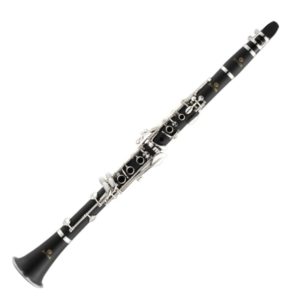 every step of the process, from learning the basics to exploring advanced techniques and musical styles.
every step of the process, from learning the basics to exploring advanced techniques and musical styles.
Be patient with yourself and celebrate your progress, no matter how small. Remember that the joy of playing the clarinet comes not only from reaching a destination but also from the continuous growth and exploration along the way.
With dedication, practice, and the right resources, you can unlock your full potential as a clarinettist and experience the beauty and versatility of this remarkable instrument. So, seize the opportunity, grab your clarinet, and embark on this exciting musical journey. Let the clarinet be your voice and express the music within you.
